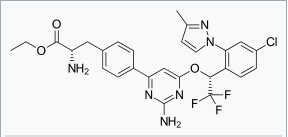Telotristat ethyl: Difference between revisions
No edit summary |
No edit summary |
||
| Line 245: | Line 245: | ||
(Description) | (Description) | ||
|drugBox={{Drugbox2 | |drugBox={{Drugbox2 | ||
| IUPAC_name = [(''S'')-Ethyl 2-amino-3-(4-(2-amino-6-((''R'')-1-(4-chloro-2-(3-methyl-1''H''-pyrazol-1-yl)phenyl)-2,2,2-trifluoroethoxy)pyrimidin-4-yl)phenyl)propanoate] | |||
| IUPAC_name = | | image = xermelowiki.png | ||
| image = | | width = 275 | ||
| | |||
<!--Clinical data--> | <!--Clinical data--> | ||
| tradename = | | tradename = Xermelo | ||
| | | Drugs.com = {{drugs.com|mtm|xermelo}} | ||
| licence_US = | | licence_US = | ||
| pregnancy_AU = | | pregnancy_AU = <!-- A / B1 / B2 / B3 / C / D / X --> | ||
| pregnancy_US = | | pregnancy_US = | ||
| legal_status = | | pregnancy_category = | ||
| routes_of_administration = | | legal_AU = <!-- S2, S3, S4, S5, S6, S7, S8, S9 or Unscheduled--> | ||
| legal_CA = <!-- Schedule I, II, III, IV, V, VI, VII, VIII --> | |||
| legal_UK = <!-- GSL, P, POM, CD, or Class A, B, C --> | |||
| legal_US = Rx-only | |||
| legal_status = | |||
| routes_of_administration = [[Oral administration|By mouth]] ([[Tablet (pharmacy)|tablets]]) | |||
<!--Pharmacokinetic data--> | <!--Pharmacokinetic data--> | ||
| bioavailability = | | bioavailability = | ||
| metabolism = | | protein_bound = >99% (both telotristat ethyl and telotristat) | ||
| elimination_half-life = | | metabolism = [[Hydrolysis]] via [[carboxylesterase]]s | ||
| excretion = | | metabolites = Telotristat | ||
| elimination_half-life = 0.6 hours (telotristat ethyl), 5 hours (telotristat) | |||
| excretion = [[Feces]] (92.8%), [[urine]] (less than 0.4%)<ref name = "PI">{{cite web | title = Xermelo (telotristat ethyl) Tablets, for Oral Use. Full Prescribing Information | url = http://www.xermelo.com/Media/Default/pdfs/Product_Info_telotristat_etiprate.pdf | publisher = Lexicon Pharmaceuticals, Inc. 8800 Technology Forest Place. The Woodlands, TX 77381 | accessdate = 1 March 2017}}</ref> | |||
<!--Identifiers--> | <!--Identifiers--> | ||
| CAS_number = 1137608-69-5 | |||
| CAS_number = | | ATC_prefix = None | ||
| ATC_prefix = | | ATC_suffix = | ||
| ATC_suffix = | | PubChem = 25181577 | ||
| PubChem = | | ChemSpiderID = 28189674 | ||
| UNII = 8G388563M7 | |||
| KEGG = D09974 | |||
| ChEMBL = 2105695 | |||
| NIAID_ChemDB = | |||
| ChemSpiderID = | | PDB_ligand = | ||
| synonyms = LX1032, LX1606 | |||
| UNII = | |||
| KEGG = | |||
| | |||
| | |||
| | |||
| | |||
<!--Chemical data--> | <!--Chemical data--> | ||
| C= | H= | N= | O= | | chemical_formula = | ||
| molecular_weight = | | C = 38 | H = 46 | F = 4 | N=6 | O=9 | S=1 | ||
| smiles = | | molecular_weight = 838.8696 g/mol | ||
| smiles = CCOC(=O)[C@@H](N)Cc1ccc(cc1)c2cc(O[C@H](c3ccc(Cl)cc3n4ccc(C)n4)C(F)(F)F)nc(N)n2 | |||
| StdInChI = 1S/C27H26ClF3N6O3/c1-3-39-25(38)20(32)12-16-4-6-17(7-5-16)21-14-23(35-26(33)34-21)40-24(27(29,30)31)19-9-8-18(28)13-22(19)37-11-10-15(2)36-37/h4-11,13-14,20,24H,3,12,32H2,1-2H3,(H2,33,34,35)/t20-,24+/m0/s1 | |||
| StdInChIKey = MDSQOJYHHZBZKA-GBXCKJPGSA-N | |||
| StdInChI = | |||
| StdInChIKey = | |||
}} | }} | ||
|mechAction=( | |mechAction= | ||
| | *Telotristat, the active metabolite of telotristat ethyl, is an inhibitor of tryptophan hydroxylase, which mediates the rate limiting step in serotonin biosynthesis. The in vitro inhibitory potency of telotristat towards tryptophan hydroxylase is 29 times higher than that of telotristat ethyl. Serotonin plays a role in mediating secretion, motility, inflammation, and sensation of the gastrointestinal tract, and is over-produced in patients with carcinoid syndrome. Through inhibition of tryptophan hydroxylase, telotristat and telotristat ethyl reduce the production of peripheral serotonin, and the frequency of carcinoid syndrome diarrhea. | ||
|structure= | |||
[[image:xermelostructure.png|none|thumb|400px|This image is provided by the National Library of Medicine.]] | |||
|PD= | |||
*In healthy subjects, telotristat ethyl 500 mg three times daily (twice the recommended dosage) for 14 days decreased whole blood serotonin and 24-hour urinary 5-hydroxyindolacetic acid (u5-HIAA) from baseline. A decrease in 24-hour u5-HIAA was observed as early as after 5 days of treatment. | |||
*In patients with metastatic neuroendocrine tumors and carcinoid syndrome diarrhea, 24-hour u5-HIAA decreased from baseline following 6 and 12 weeks of treatment with Xermelo 250 mg three times a day, whereas placebo did not decrease u5-HIAA. | |||
=====Cardiac Electrophysiology===== | |||
*At a dose 6 times the recommended dose of 250 mg, Xermelo does not prolong the QT interval to any clinically relevant extent. | |||
|PK= | |||
=====Absorption===== | |||
*After a single oral dose of telotristat ethyl to healthy subjects, telotristat ethyl was absorbed and metabolized to its active metabolite, telotristat. Peak plasma concentrations of telotristat ethyl were achieved within 0.5 to 2 hours, and those of telotristat within 1 to 3 hours. Plasma concentrations thereafter declined in a biphasic manner. Following administration of a single 500 mg dose of telotristat ethyl (twice the recommended dosage) under fasted conditions in healthy subjects, the mean C<sub>max</sub> and AUC<sub>0-inf</sub> were 4.4 ng/mL and 6.23 ng•hr/mL, respectively for telotristat ethyl. The mean C<sub>max</sub> and AUC<sub>0-inf</sub> were 610 ng/mL and 2320 ng•hr/mL, respectively for telotristat. Peak plasma concentrations and AUC of telotristat ethyl and telotristat appeared to be dose proportional following administration of a single dose of telotristat ethyl in the range of 100 mg (0.4 times the lowest recommended dose to 1000 mg [4 times the highest recommended dose]) under fasted conditions. | |||
*Following multiple-dose administration of telotristat ethyl 500 mg three times daily, there was negligible accumulation at steady state for both telotristat ethyl and telotristat. | |||
*In patients with metastatic neuroendocrine tumors and carcinoid syndrome diarrhea treated with SSA therapy, the median T<sub>max</sub> for telotristat ethyl and telotristat was approximately 1 and 2 hours, respectively. Following administration of 500 mg telotristat ethyl three times daily, with meals in patients, the mean C<sub>max</sub> and AUC<sub>0-6hr</sub> were approximately 7 ng/mL and 22 ng•hr/mL, respectively, for telotristat ethyl. The mean C<sub>max</sub> and AUC<sub>0-6hr</sub> were approximately 900 ng/mL and 3000 ng•hr/mL, respectively for telotristat. The pharmacokinetic parameters for both telotristat ethyl and telotristat were highly variable with about 55% coefficient of variation. | |||
''Food Effect'' | |||
*Administration of a single 500 mg dose of Xermelo (twice the recommended dose) with food resulted in higher exposure to both telotristat ethyl and telotristat. The systemic exposure to telotristat ethyl, was significantly increased following administration with a high-fat meal, with C<sub>max</sub>, and AUC<sub>0-inf</sub> being 112%, and 264% higher, respectively compared to the fasted state. Following administration of a single 500 mg dose of telotristat ethyl under the fed conditions in healthy subjects, the mean C<sub>max</sub> and AUC<sub>0-inf</sub> were 10.5 ng/mL and 21.6 ng•hr/mL, respectively for telotristat ethyl. The C<sub>max</sub> and AUC<sub>0-inf</sub> values for telotristat were also increased by 47% and 33%, respectively, with a high-fat meal compared to the fasted state. The mean C<sub>max</sub> and AUC<sub>0-inf</sub> were 908 ng/mL and 2980 ng•hr/mL, respectively for telotristat under the fed condition. | |||
===== Distribution===== | |||
*Both telotristat ethyl and telotristat are greater than 99% bound to human plasma proteins. | |||
*In vitro data suggests that telotristat is a substrate of P-glycoprotein. | |||
=====Elimination===== | |||
*Following a single 500 mg oral dose of telotristat ethyl in healthy subjects, the apparent half-life was approximately 0.6 hours for telotristat ethyl and 5 hours for telotristat. The apparent total clearance at steady state (CL/F<sub>ss</sub>) following oral dosing with telotristat ethyl 500 mg three times daily for 14 days (twice the recommended dosage) in healthy subjects was 2.7 and 152 L/hr for telotristat ethyl and telotristat, respectively. | |||
''Metabolism'' | |||
*After oral administration, telotristat ethyl undergoes hydrolysis via carboxylesterases to telotristat, its active metabolite. Telotristat is further metabolized. Among the metabolites of telotristat, the systemic exposure to an acid metabolite of oxidative deaminated decarboxylated telotristat was about 35% of that of telotristat. In vitro data suggest that telotristat ethyl and telotristat are not substrates for CYP enzymes. | |||
''Excretion'' | |||
*Following a single 500 mg oral dose of <sup>14</sup>C-telotristat ethyl, 93.2% of the dose was recovered over 240 hours: 92.8% was recovered in the feces, with less than 0.4% being recovered in the urine. | |||
=====Specific Populations===== | |||
''Age and Sex'' | |||
*Population pharmacokinetic analysis indicated that age (18 to 83 years) and sex do not affect the pharmacokinetics of telotristat. | |||
''Renal Impairment'' | |||
*Population pharmacokinetic analysis indicated that creatinine clearance (20 to 89 mL/min) does not affect the pharmacokinetics of telotristat. Xermelo was not studied in end-stage renal disease (ESRD) patients who require dialysis. | |||
''Hepatic Impairment'' | |||
*Population pharmacokinetic analysis indicated that mild hepatic impairment (defined as total bilirubin greater than 1 to 1.5 times the upper limit of normal [ULN] or AST greater than the ULN) does not affect the pharmacokinetics of telotristat. The effect of moderate or severe hepatic impairment (defined as total bilirubin greater than 1.5 times the ULN and any value for AST) is unknown. | |||
=====Drug Interaction Studies===== | |||
''Effect of Telotristat Ethyl on Other Drugs'' | |||
=====In vitro studies===== | |||
*The potential for telotristat ethyl and telotristat to induce CYP enzymes (1A2 and 2B6) or inhibit CYP enzymes (2B6, 2C8, and 2C9) has not been adequately studied in vitro. | |||
*In vitro telotristat ethyl inhibited P-glycoprotein (P-gp) and breast cancer resistance protein (BCRP), but telotristat did not inhibit P-gp and BCRP at the clinically relevant concentrations. However, in vivo drug interaction potential via inhibition of BCRP is low based on in vitro studies and in vivo findings. | |||
*Based on in vitro studies, in vivo drug interaction potential via inhibition of organic cation transporter 1 (OCT1), OCT2, organic anion transporter 1 (OAT1), OAT3, organic anion transporting polypeptide 1B1 (OATP1B1), OATP1B3, or bile salt export pump (BSEP) transporters by telotristat ethyl and telotristat is low at the recommended dosage. | |||
=====Midazolam (sensitive CYP3A4 substrate)===== | |||
*Following administration of multiple doses of telotristat ethyl, the systemic exposure to concomitant midazolam was significantly decreased. When 3 mg midazolam was co-administered orally after 5 day treatment with telotristat ethyl 500 mg three times daily (twice the recommended dosage), the mean C<sub>max</sub>, and AUC<sub>0-inf</sub> for midazolam were decreased by 25%, and 48%, respectively, compared to administration of midazolam alone. The mean C<sub>max</sub>, and AUC<sub>0-inf</sub> for the active metabolite, 1'-hydroxymidazolam, were also decreased by 34%, and 48%, respectively. The reduction in the systemic exposure to both midazolam and its active metabolite suggests that the glucuronidation of 1'-hydroxymidazolam may have been increased by telotristat ethyl. | |||
=====Fexofenadine (sensitive P-gp substrate)===== | |||
*The C<sub>max</sub> and AUC of fexofenadine increased by 16% when a single 180 mg dose of fexofenadine was co-administered orally with the final dose of telotristat ethyl 500 mg administered three times daily (twice the recommended dosage) for 5 days. Clinically meaningful interactions with P-gp substrates are unlikely. | |||
''Effect of Other Drugs on Telotristat Ethyl'' | |||
''Short-Acting Octreotide'' | |||
*The mean C<sub>max</sub> and AUC<sub>0-last</sub> of telotristat ethyl were decreased by 86% and 81%, respectively, following administration of a single 500 mg dose of Xermelo (twice the recommended dose), co-administered with short-acting octreotide 200 mcg injected subcutaneously in healthy subjects. The mean C<sub>max</sub> and AUC<sub>0-last</sub> of telotristat were decreased by 79% and 68%, respectively. | |||
|nonClinToxic= | |nonClinToxic= | ||
=====Carcinogenesis, Mutagenesis, Impairment of Fertility===== | =====Carcinogenesis, Mutagenesis, Impairment of Fertility===== | ||
Revision as of 16:22, 30 July 2018
Editor-In-Chief: C. Michael Gibson, M.S., M.D. [1]; Associate Editor(s)-in-Chief: Sonya Gelfand
Disclaimer
WikiDoc MAKES NO GUARANTEE OF VALIDITY. WikiDoc is not a professional health care provider, nor is it a suitable replacement for a licensed healthcare provider. WikiDoc is intended to be an educational tool, not a tool for any form of healthcare delivery. The educational content on WikiDoc drug pages is based upon the FDA package insert, National Library of Medicine content and practice guidelines / consensus statements. WikiDoc does not promote the administration of any medication or device that is not consistent with its labeling. Please read our full disclaimer here.
Black Box Warning
|
Warning Title
See full prescribing information for complete Boxed Warning.
Condition Name: (Content)
|
Overview
Telotristat ethyl is a Acetylcholine release inhibitor, Adrenergic receptor agonist that is FDA approved for the (type of indication of drug) of a list of indications, separated by commas.. There is a Black Box Warning for this drug as shown here. Common adverse reactions include a list of adverse reactions, separated by commas..
Adult Indications and Dosage
FDA-Labeled Indications and Dosage (Adult)
Condition 1
- Dosing Information
- (Dosage)
Condition 2
- Dosing Information
- (Dosage)
Off-Label Use and Dosage (Adult)
Guideline-Supported Use
Condition 1
- Developed by: (Organisation)
- Class of Recommendation: (Class) (Link)
- Strength of Evidence: (Category A/B/C) (Link)
- Dosing Information/Recommendation
- (Dosage)
Condition 2
- Developed by: (Organisation)
- Class of Recommendation: (Class) (Link)
- Strength of Evidence: (Category A/B/C) (Link)
- Dosing Information/Recommendation
- (Dosage)
Non–Guideline-Supported Use
Condition 1
- Dosing Information
- (Dosage)
Condition 2
- Dosing Information
- (Dosage)
Condition 3
- Dosing Information
- (Dosage)
Pediatric Indications and Dosage
FDA-Labeled Indications and Dosage (Pediatric)
Condition 1
- Dosing Information
- (Dosage)
Condition 2
- Dosing Information
- (Dosage)
Off-Label Use and Dosage (Pediatric)
Guideline-Supported Use
Condition 1
- Developed by: (Organisation)
- Class of Recommendation: (Class) (Link)
- Strength of Evidence: (Category A/B/C) (Link)
- Dosing Information/Recommendation
- (Dosage)
Condition 2
- Developed by: (Organisation)
- Class of Recommendation: (Class) (Link)
- Strength of Evidence: (Category A/B/C) (Link)
- Dosing Information/Recommendation
- (Dosage)
Non–Guideline-Supported Use
Condition 1
- Dosing Information
- (Dosage)
Condition 2
- Dosing Information
- (Dosage)
Condition 3
- Dosing Information
- (Dosage)
Contraindications
CONTRAINDICATIONS
Warnings
|
Warning Title
See full prescribing information for complete Boxed Warning.
Condition Name: (Content)
|
Conidition 1
(Description)
Conidition 2
(Description)
Conidition 3
(Description)
Adverse Reactions
Clinical Trials Experience
Central Nervous System
- (list/description of adverse reactions)
Cardiovascular
- (list/description of adverse reactions)
Respiratory
- (list/description of adverse reactions)
Gastrointestinal
- (list/description of adverse reactions)
Hypersensitive Reactions
- (list/description of adverse reactions)
Miscellaneous
- (list/description of adverse reactions)
Condition 2
Central Nervous System
- (list/description of adverse reactions)
Cardiovascular
- (list/description of adverse reactions)
Respiratory
- (list/description of adverse reactions)
Gastrointestinal
- (list/description of adverse reactions)
Hypersensitive Reactions
- (list/description of adverse reactions)
Miscellaneous
- (list/description of adverse reactions)
Postmarketing Experience
(Description)
Drug Interactions
- Drug 1
- Drug 2
- Drug 3
- Drug 4
- Drug 5
Drug 1
(Description)
Drug 2
(Description)
Drug 3
(Description)
Drug 4
(Description)
Drug 5
(Description)
Use in Specific Populations
Pregnancy
Pregnancy Category (FDA):
(Description)
Pregnancy Category (AUS):
There is no Australian Drug Evaluation Committee (ADEC) guidance on usage of Telotristat ethyl in women who are pregnant.
Labor and Delivery
(Description)
Nursing Mothers
(Description)g
Pediatric Use
(Description)
Geriatic Use
(Description)
Gender
(Description)
Race
(Description)
Renal Impairment
(Description)
Hepatic Impairment
(Description)
Females of Reproductive Potential and Males
(Description)
Immunocompromised Patients
(Description)
Others
(Description)
Administration and Monitoring
Administration
(Oral/Intravenous/etc)
Monitoring
Condition 1
(Description regarding monitoring, from Warnings section)
Condition 2
(Description regarding monitoring, from Warnings section)
Condition 3
(Description regarding monitoring, from Warnings section)
IV Compatibility
There is limited information regarding the compatibility of Telotristat ethyl and IV administrations.
Overdosage
Acute Overdose
Signs and Symptoms
(Description)
Management
(Description)
Chronic Overdose
Signs and Symptoms
(Description)
Management
(Description)
Pharmacology
Mechanism of Action
- Telotristat, the active metabolite of telotristat ethyl, is an inhibitor of tryptophan hydroxylase, which mediates the rate limiting step in serotonin biosynthesis. The in vitro inhibitory potency of telotristat towards tryptophan hydroxylase is 29 times higher than that of telotristat ethyl. Serotonin plays a role in mediating secretion, motility, inflammation, and sensation of the gastrointestinal tract, and is over-produced in patients with carcinoid syndrome. Through inhibition of tryptophan hydroxylase, telotristat and telotristat ethyl reduce the production of peripheral serotonin, and the frequency of carcinoid syndrome diarrhea.
Structure
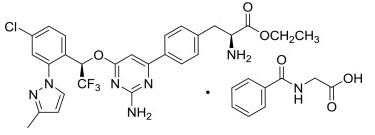
Pharmacodynamics
- In healthy subjects, telotristat ethyl 500 mg three times daily (twice the recommended dosage) for 14 days decreased whole blood serotonin and 24-hour urinary 5-hydroxyindolacetic acid (u5-HIAA) from baseline. A decrease in 24-hour u5-HIAA was observed as early as after 5 days of treatment.
- In patients with metastatic neuroendocrine tumors and carcinoid syndrome diarrhea, 24-hour u5-HIAA decreased from baseline following 6 and 12 weeks of treatment with Xermelo 250 mg three times a day, whereas placebo did not decrease u5-HIAA.
Cardiac Electrophysiology
- At a dose 6 times the recommended dose of 250 mg, Xermelo does not prolong the QT interval to any clinically relevant extent.
Pharmacokinetics
Absorption
- After a single oral dose of telotristat ethyl to healthy subjects, telotristat ethyl was absorbed and metabolized to its active metabolite, telotristat. Peak plasma concentrations of telotristat ethyl were achieved within 0.5 to 2 hours, and those of telotristat within 1 to 3 hours. Plasma concentrations thereafter declined in a biphasic manner. Following administration of a single 500 mg dose of telotristat ethyl (twice the recommended dosage) under fasted conditions in healthy subjects, the mean Cmax and AUC0-inf were 4.4 ng/mL and 6.23 ng•hr/mL, respectively for telotristat ethyl. The mean Cmax and AUC0-inf were 610 ng/mL and 2320 ng•hr/mL, respectively for telotristat. Peak plasma concentrations and AUC of telotristat ethyl and telotristat appeared to be dose proportional following administration of a single dose of telotristat ethyl in the range of 100 mg (0.4 times the lowest recommended dose to 1000 mg [4 times the highest recommended dose]) under fasted conditions.
- Following multiple-dose administration of telotristat ethyl 500 mg three times daily, there was negligible accumulation at steady state for both telotristat ethyl and telotristat.
- In patients with metastatic neuroendocrine tumors and carcinoid syndrome diarrhea treated with SSA therapy, the median Tmax for telotristat ethyl and telotristat was approximately 1 and 2 hours, respectively. Following administration of 500 mg telotristat ethyl three times daily, with meals in patients, the mean Cmax and AUC0-6hr were approximately 7 ng/mL and 22 ng•hr/mL, respectively, for telotristat ethyl. The mean Cmax and AUC0-6hr were approximately 900 ng/mL and 3000 ng•hr/mL, respectively for telotristat. The pharmacokinetic parameters for both telotristat ethyl and telotristat were highly variable with about 55% coefficient of variation.
Food Effect
- Administration of a single 500 mg dose of Xermelo (twice the recommended dose) with food resulted in higher exposure to both telotristat ethyl and telotristat. The systemic exposure to telotristat ethyl, was significantly increased following administration with a high-fat meal, with Cmax, and AUC0-inf being 112%, and 264% higher, respectively compared to the fasted state. Following administration of a single 500 mg dose of telotristat ethyl under the fed conditions in healthy subjects, the mean Cmax and AUC0-inf were 10.5 ng/mL and 21.6 ng•hr/mL, respectively for telotristat ethyl. The Cmax and AUC0-inf values for telotristat were also increased by 47% and 33%, respectively, with a high-fat meal compared to the fasted state. The mean Cmax and AUC0-inf were 908 ng/mL and 2980 ng•hr/mL, respectively for telotristat under the fed condition.
Distribution
- Both telotristat ethyl and telotristat are greater than 99% bound to human plasma proteins.
- In vitro data suggests that telotristat is a substrate of P-glycoprotein.
Elimination
- Following a single 500 mg oral dose of telotristat ethyl in healthy subjects, the apparent half-life was approximately 0.6 hours for telotristat ethyl and 5 hours for telotristat. The apparent total clearance at steady state (CL/Fss) following oral dosing with telotristat ethyl 500 mg three times daily for 14 days (twice the recommended dosage) in healthy subjects was 2.7 and 152 L/hr for telotristat ethyl and telotristat, respectively.
Metabolism
- After oral administration, telotristat ethyl undergoes hydrolysis via carboxylesterases to telotristat, its active metabolite. Telotristat is further metabolized. Among the metabolites of telotristat, the systemic exposure to an acid metabolite of oxidative deaminated decarboxylated telotristat was about 35% of that of telotristat. In vitro data suggest that telotristat ethyl and telotristat are not substrates for CYP enzymes.
Excretion
- Following a single 500 mg oral dose of 14C-telotristat ethyl, 93.2% of the dose was recovered over 240 hours: 92.8% was recovered in the feces, with less than 0.4% being recovered in the urine.
Specific Populations
Age and Sex
- Population pharmacokinetic analysis indicated that age (18 to 83 years) and sex do not affect the pharmacokinetics of telotristat.
Renal Impairment
- Population pharmacokinetic analysis indicated that creatinine clearance (20 to 89 mL/min) does not affect the pharmacokinetics of telotristat. Xermelo was not studied in end-stage renal disease (ESRD) patients who require dialysis.
Hepatic Impairment
- Population pharmacokinetic analysis indicated that mild hepatic impairment (defined as total bilirubin greater than 1 to 1.5 times the upper limit of normal [ULN] or AST greater than the ULN) does not affect the pharmacokinetics of telotristat. The effect of moderate or severe hepatic impairment (defined as total bilirubin greater than 1.5 times the ULN and any value for AST) is unknown.
Drug Interaction Studies
Effect of Telotristat Ethyl on Other Drugs
In vitro studies
- The potential for telotristat ethyl and telotristat to induce CYP enzymes (1A2 and 2B6) or inhibit CYP enzymes (2B6, 2C8, and 2C9) has not been adequately studied in vitro.
- In vitro telotristat ethyl inhibited P-glycoprotein (P-gp) and breast cancer resistance protein (BCRP), but telotristat did not inhibit P-gp and BCRP at the clinically relevant concentrations. However, in vivo drug interaction potential via inhibition of BCRP is low based on in vitro studies and in vivo findings.
- Based on in vitro studies, in vivo drug interaction potential via inhibition of organic cation transporter 1 (OCT1), OCT2, organic anion transporter 1 (OAT1), OAT3, organic anion transporting polypeptide 1B1 (OATP1B1), OATP1B3, or bile salt export pump (BSEP) transporters by telotristat ethyl and telotristat is low at the recommended dosage.
Midazolam (sensitive CYP3A4 substrate)
- Following administration of multiple doses of telotristat ethyl, the systemic exposure to concomitant midazolam was significantly decreased. When 3 mg midazolam was co-administered orally after 5 day treatment with telotristat ethyl 500 mg three times daily (twice the recommended dosage), the mean Cmax, and AUC0-inf for midazolam were decreased by 25%, and 48%, respectively, compared to administration of midazolam alone. The mean Cmax, and AUC0-inf for the active metabolite, 1'-hydroxymidazolam, were also decreased by 34%, and 48%, respectively. The reduction in the systemic exposure to both midazolam and its active metabolite suggests that the glucuronidation of 1'-hydroxymidazolam may have been increased by telotristat ethyl.
Fexofenadine (sensitive P-gp substrate)
- The Cmax and AUC of fexofenadine increased by 16% when a single 180 mg dose of fexofenadine was co-administered orally with the final dose of telotristat ethyl 500 mg administered three times daily (twice the recommended dosage) for 5 days. Clinically meaningful interactions with P-gp substrates are unlikely.
Effect of Other Drugs on Telotristat Ethyl Short-Acting Octreotide
- The mean Cmax and AUC0-last of telotristat ethyl were decreased by 86% and 81%, respectively, following administration of a single 500 mg dose of Xermelo (twice the recommended dose), co-administered with short-acting octreotide 200 mcg injected subcutaneously in healthy subjects. The mean Cmax and AUC0-last of telotristat were decreased by 79% and 68%, respectively.
Nonclinical Toxicology
Carcinogenesis, Mutagenesis, Impairment of Fertility
- In a 26-week study in transgenic (Tg.rasH2) mice, telotristat ethyl was not tumorigenic at oral doses up to 300 mg/kg/day.
- Telotristat ethyl was negative in the in vitro Ames test, the in vitro chromosomal aberration test using Chinese hamster ovary cells, and the in vivo rat micronucleus test.
- Telotristat ethyl at oral doses up to 500 mg/kg/day (approximately 5 times the AUC for the active metabolite at the RHD) was found to have no effect on fertility and reproductive performance of male or female rats.
Clinical Studies
- A 12-week double-blind, placebo-controlled, randomized, multicenter trial of Xermelo was conducted in adult patients with a well-differentiated metastatic neuroendocrine tumor and carcinoid syndrome diarrhea who were having between 4 to 12 daily bowel movements despite the use of SSA therapy at a stable dose for at least 3 months. Patients were randomized to placebo or treatment with Xermelo 250 mg three times daily.
- Study medication was administered within 15 minutes before or within 1 hour after a meal or snack. All patients were required to stay on their baseline SSA regimen and were allowed to use rescue medication (short-acting octreotide) and antidiarrheals (e.g., loperamide) for symptomatic relief. A total of 90 patients were evaluated for efficacy. The mean age of the population was 63 years of age (range 37 to 83 years), 50% were male, and 90% were White.
- The primary efficacy endpoint was the change from baseline in the number of daily bowel movements averaged over the 12-week treatment period. The analysis results can be found in TABLE 2 below. The average was based on the number of days with valid, non-missing data. When a patient had more than 6 weeks of missing data, the change from baseline was considered equal to zero. A week of missing data was defined as a patient missing at least 4 days of diary data in that week.
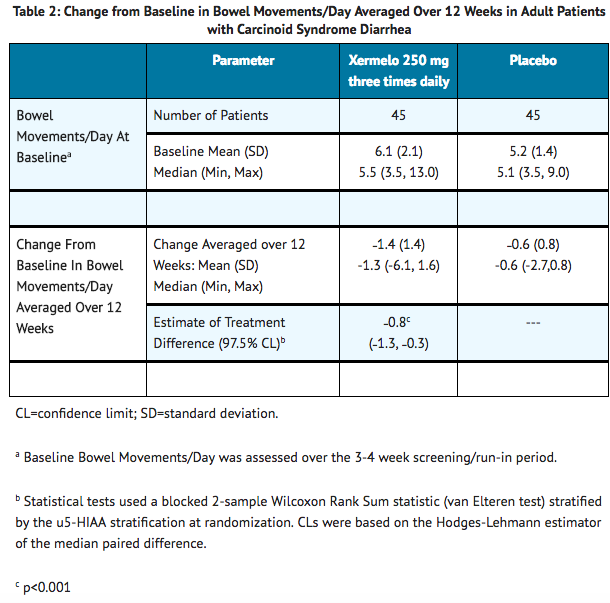
- In the 12-week study, a difference in average weekly reductions in bowel movement frequency between Xermelo and placebo was observed as early as 1 to 3 weeks, and persisted for the remaining 9 weeks of the study.
- To aid in the interpretation of the bowel movement reduction results, the proportion of patients reporting any particular level of reduction in overall average bowel movement frequency is depicted in Figure 1 below. For example, 33% of patients randomized to Xermelo and 4% of patients randomized to placebo experienced a reduction in overall average bowel movements from baseline of at least 2 bowel movements per day.
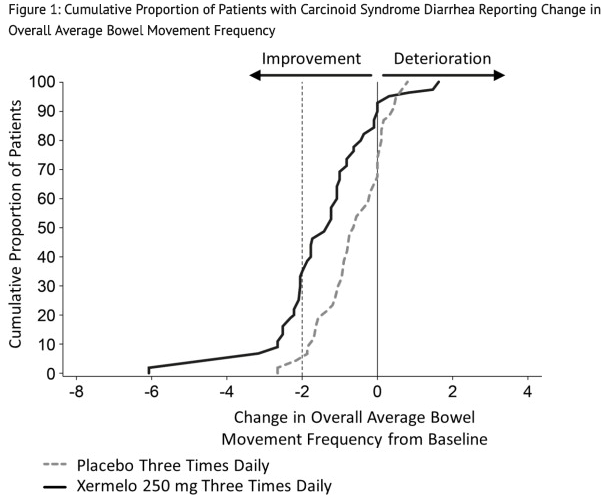
- Other symptoms of carcinoid syndrome (abdominal pain or flushing) did not show improvement in the comparison of Xermelo to placebo.
- The average number of daily short-acting octreotide injections used for rescue therapy over the 12-week double-blind treatment period was 0.3 and 0.7 in the Xermelo and placebo groups, respectively. In the subgroup of patients who received short-acting octreotide injections, observed reductions in the number of bowel movements per day and treatment differences were generally consistent with the reductions and differences observed in patients who did not receive rescue therapy, and were similar to the overall data presented in TABLE 2 above.
- A third randomized treatment arm of Xermelo 500 mg three times daily did not demonstrate additional treatment benefit on the primary endpoint and had a greater incidence of adverse reactions than Xermelo 250 mg three times daily. Therefore, Xermelo 500 mg three times daily is not recommended.
How Supplied
- 250 mg tablet: white to off-white coated oval tablet with “T-E” debossed on one side and “250” debossed on the other side.
- Xermelo is dispensed in a monthly case for a total of 28 days of therapy. Each monthly case contains four weekly boxes. Each weekly box contains seven daily dose packs (day pack).
- NDC 70183-125-84: Monthly case of 84 tablets. Each child resistant daily dose pack (day pack) contains three 250 mg tablets.
Storage
- Store at 25°C (77°F); excursions permitted to 15°C to 30°C (59°F to 86°F).
Images
Drug Images
{{#ask: Page Name::Telotristat ethyl |?Pill Name |?Drug Name |?Pill Ingred |?Pill Imprint |?Pill Dosage |?Pill Color |?Pill Shape |?Pill Size (mm) |?Pill Scoring |?NDC |?Drug Author |format=template |template=DrugPageImages |mainlabel=- |sort=Pill Name }}
Package and Label Display Panel
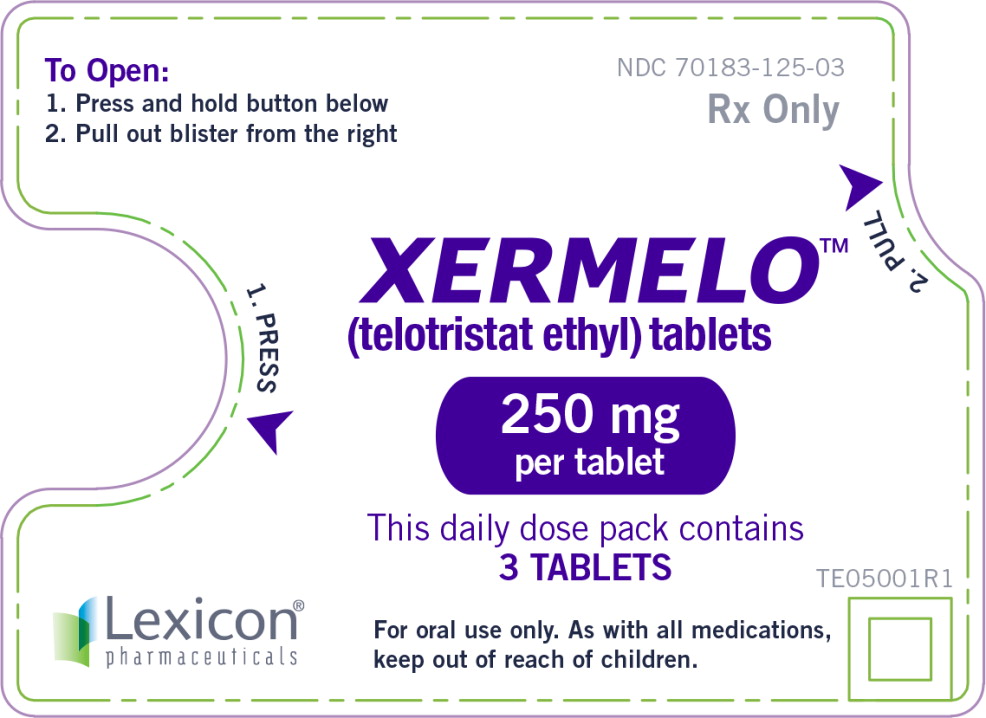
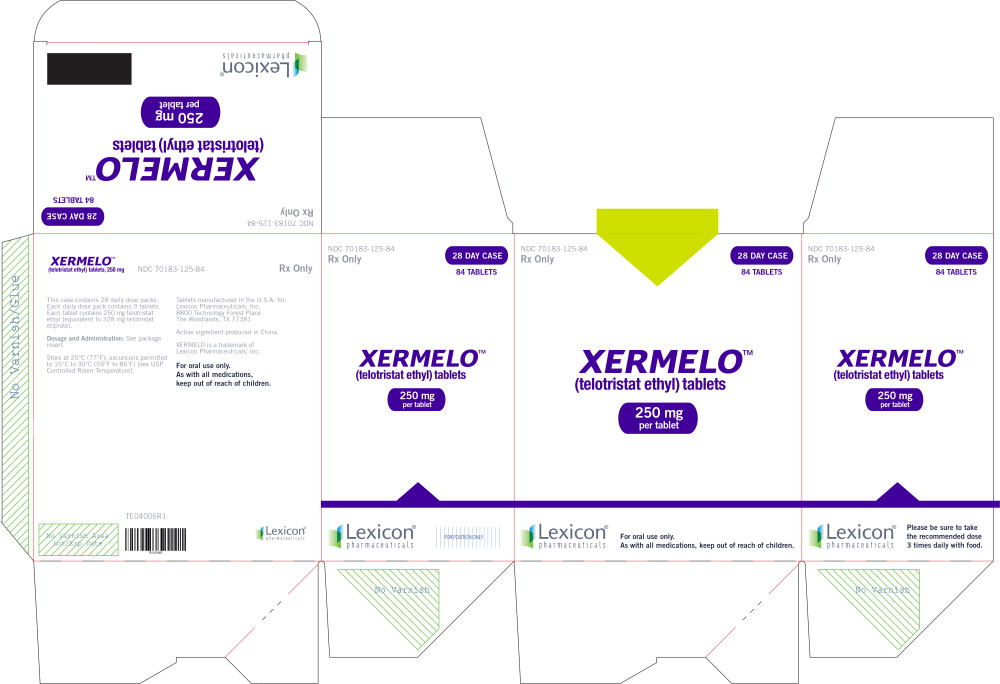
{{#ask: Label Page::Telotristat ethyl |?Label Name |format=template |template=DrugLabelImages |mainlabel=- |sort=Label Page }}
Patient Counseling Information
- Advise patients:
- If they experience severe constipation or severe persistent or worsening abdominal pain, to discontinue Xermelo and contact their healthcare provider.
- To take Xermelo with food.
- When short-acting octreotide is used in combination with Xermelo, administer short-acting octreotide at least 30 minutes after administering Xermelo.
- If a dose is missed, take the next dose at the regular time. Do not take 2 doses at the same time to make up for a missed dose.
Precautions with Alcohol
Alcohol-Telotristat ethyl interaction has not been established. Talk to your doctor regarding the effects of taking alcohol with this medication.
Brand Names
- Xermelo
Look-Alike Drug Names
There is limited information regarding Telotristat ethyl Look-Alike Drug Names in the drug label.
Drug Shortage Status
Drug Shortage
Price
References
The contents of this FDA label are provided by the National Library of Medicine.
- ↑ "Xermelo (telotristat ethyl) Tablets, for Oral Use. Full Prescribing Information" (PDF). Lexicon Pharmaceuticals, Inc. 8800 Technology Forest Place. The Woodlands, TX 77381. Retrieved 1 March 2017.
